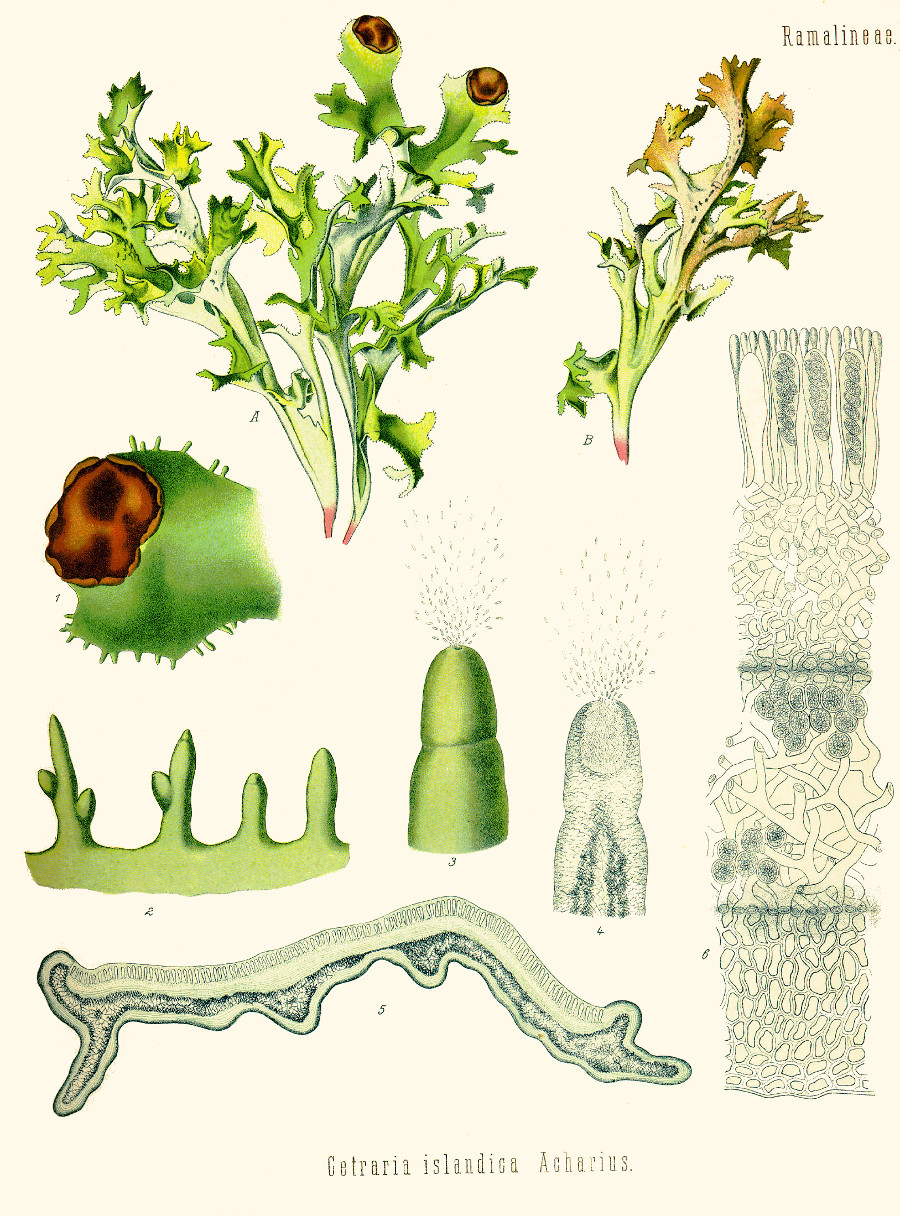Cetraria islandica (L.) Ach. - Parmeliaceae - Iceland lichen, Iceland moss, Isländisch Moos
Lichen, native to the arctic area, Northern America, Iceland, and Great Britain.
„Cetraria islandica is a fruticose lichen with a small to medium brown thallus growing loosely on the soil. It is usually tufted, many lobed, and irregularly branched. Colonies … 5-20cm broad. Apothecia are generally rare. Cetraria islandica exhibits cushionlike growth, making it well suited to weather high winds in harsh environments. It imbibes water slowly and can endure prolonged wet periods. Its phycobiant member is of the genus Aspicilia which has optimum photosynthetic rates at the low temperatures found in alpine environments.“ http://www.fs.fed.us/database/feis/lichens/cetisl/all.html
Pharmaceutical preparations containing extracts of Iceland moss are used to treat hoarseness and dryness of the mucosa of mouth and throat, pharyngitis, laryngitis, and dry cough in acute and chronic bronchitis.
Polyketide synthesis in C.islandica leads to protocetraric acid, fumarprotocetraric acid, confumarprotocetraric acid, succin-protocetraric acid (protolichesterinic acid). Lichens produce also polysaccharides in considerable amounts. „ … lichen glucans are linear polymers of glucosyl units connected by a variety of O-glycosidic linkages and are classified into β-glucans (lichenan, pustulan, laminaran, and branched β-glucan) and α-glucans (isolichenan, nigeran, and pullulan). … Lichenan is a cold-water-insoluble, linear (1→3)-(1→4)-β-glucan with a linkage ratio of 3:7 and was the first polysaccharide isolated from a lichen species (Cetraria islandica) in 1815 by Berzelius…“
[Accumulation of Potential Pharmaceutically Relevant Lichen Metabolites in Lichens and Cultured Lichen Symbionts., Iacomini, M., Studies in Natural Products Chemistry, 2013, 337-380]
„Traditional herbal medicinal product used as a demulcent for the symptomatic treatment of oral or pharyngeal irritation and associated dry cough… Traditional herbal medicinal product used in temporary loss of appetite. The product is a traditional herbal medicinal product for use in specified indications exclusively
based upon long-standing use…“
[European Union herbal monograph on Cetraria islandica (L.) Acharius s.l., thallus., 2014] http://www.ema.europa.eu/docs/en_GB/document_library/Herbal_-_Community_herbal_monograph/2015/02/WC500182211.pdf
From Iceland moss, Cetraria islandica (L.) Ach. a polysaccharide with pronounced immunostimulating activity in an in vitro phagocytosis assay and in the in in vivo carbon clearance assay was isolated. It is a branched galactomannan with a backbone composed of two structural elements: (1→6)-linked α-D-mannopyranosyl and α-D-(1→6)-galactopyranosyl units.
[Immunologically active polysaccharide from Cetraria islandica., Ingolfsdottir, K., Jurcic, K., Fischer, B., Wagner, H., Planta medica, 60(6), 1994, 527-531]
Protolichesterinic acid content of Cetraria islandica varies between 0.1-0.5% dry weight and fumarprotocetraric acid content varies between 2.6-11.5% depending on collection site.
[Quantitative determination of protolichesterinic-and fumarprotocetraric acids in Cetraria islandica by high-performance liquid chromatography., Gudjónsdóttir, G.A., Ingólfsdóttir, K., Journal of Chromatography A, 757(1), 1997, 303-306]
„A polysaccharide, Ci-3, resembling isolichenan except with a much higher degree of polymerization, has been isolated from the water extract, as well as from the alkali extract, of the lichen Cetraria islandica (L.)… The mean Mr of Ci-3 was determined to be 2000 kD, compared to 6-8 kD reported for isolichenan. The structure of Ci-3 was elucidated and found to be composed of (1→3)- and (1→4)-α-D-glucopyranosyl units in the ratio of 2:1 … The immunomodulating activity of Ci-3 was tested in an in vitro phagocytosis assay and anti-complementary, and proved to be active in both tests.“
[Immunologically active (1→3)-(1→4)-α-D-glucan from Cetraria islandica., Olafsdottir, E.S., Ingolfsdottir, K., Barsett, H., Paulsen, B.S., Jurcic, K., Wagner, H., Phytomedicine, 6(1), 1999, 33-39]
„Human monocyte-derived immature dendritic cells were cultured with an aqueous extract from C. islandica quantified with regard to the polysaccharides lichenan and isolichenan and secondary metabolites protolichesterinic and fumarprotocetraric acids. The purified compounds were also tested individually. Their effect on the maturation of the dendritic cells was assessed by measuring secretion of IL-10 and IL-12p40 and expression of surface molecules. In addition, the effect of the aqueous extract on antigen-induced arthritis in rats was investigated. The aqueous extract caused upregulated secretion of both IL-10 and IL-12p40, with IL-10 secretion being more prominent. Lichenan had similar effects, whereas isolichenan and the secondary metabolites were inactive, suggesting that the effect observed by the aqueous extract was mainly mediated by lichenan. Significantly less arthritis was observed for rats treated by the aqueous extract, administered subcutaneously, compared with rats treated with saline alone. These results suggest that the aqueous extract of C. islandica has anti-inflammatory effect, possibly by changing the cytokine secretion bias from IL-12p40 towards IL-10.“
[In vitro and in vivo immunomodulating effects of traditionally prepared extract and purified compounds from Cetraria islandica., Freysdottir, J., Omarsdottir, S., Ingólfsdóttir, K., Vikingsson, A., Olafsdottir, E. S., International immunopharmacology, 8(3), 2008, 423-430]
